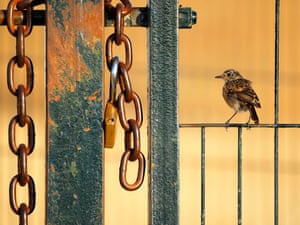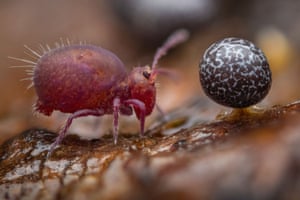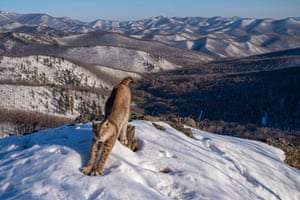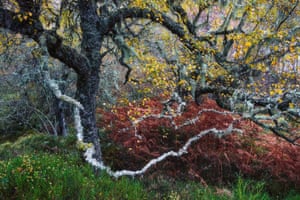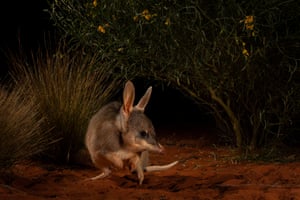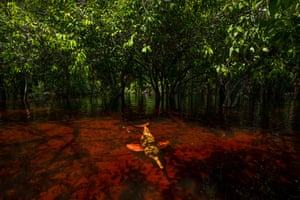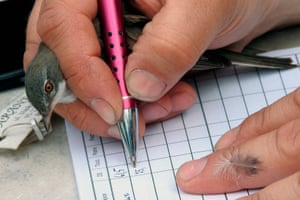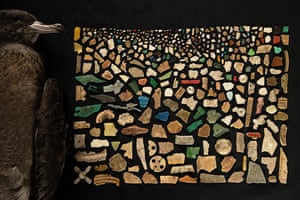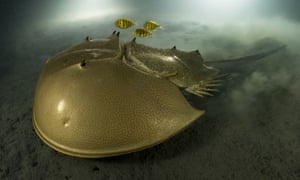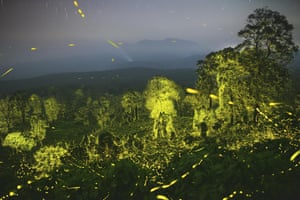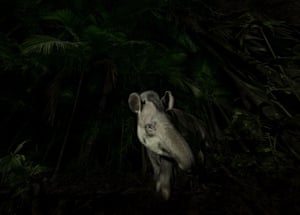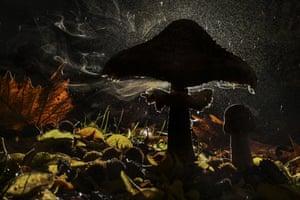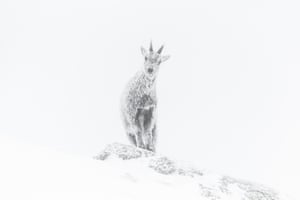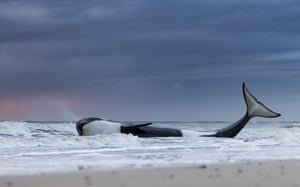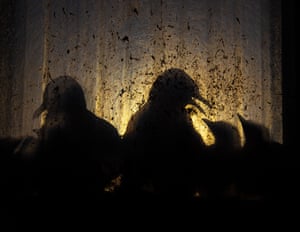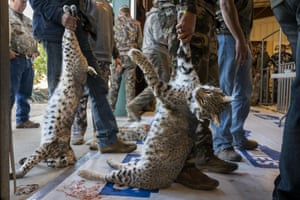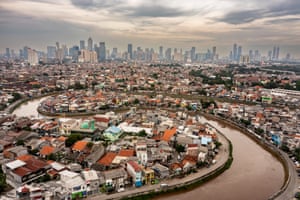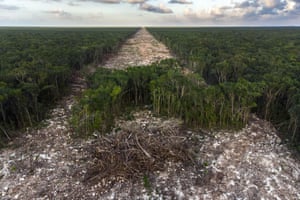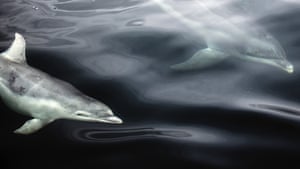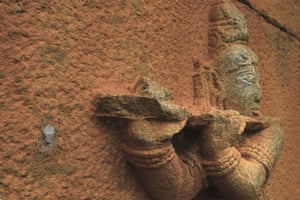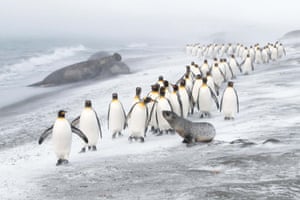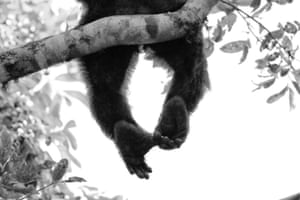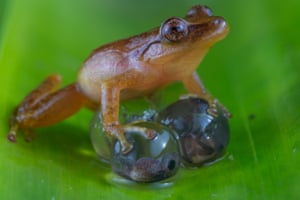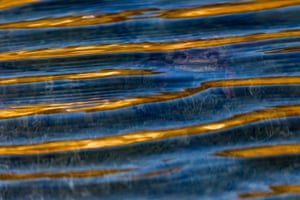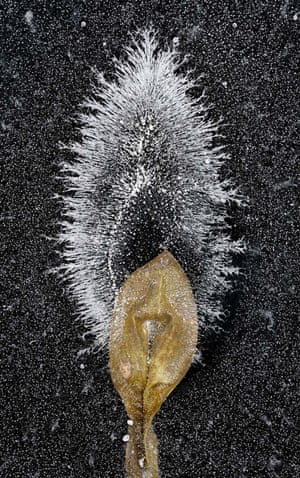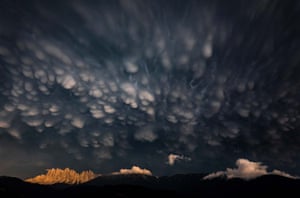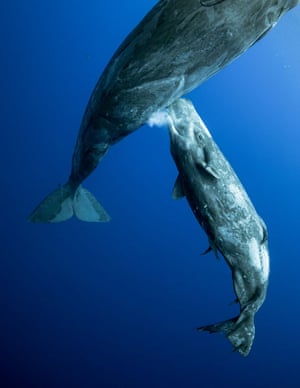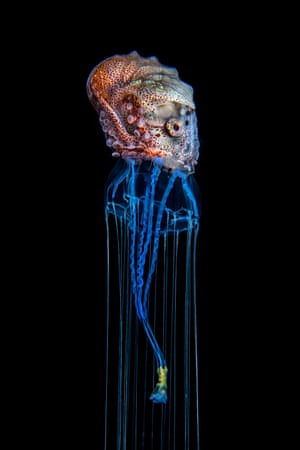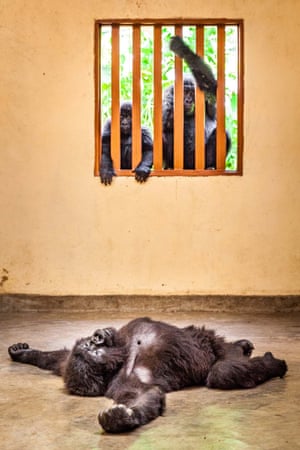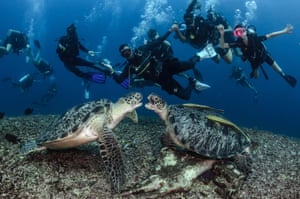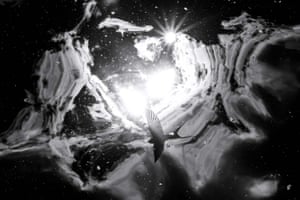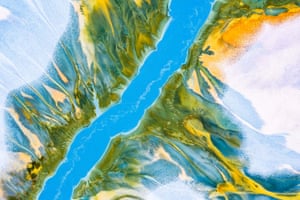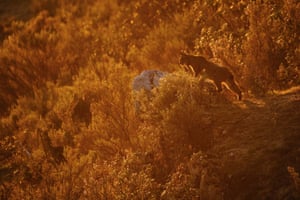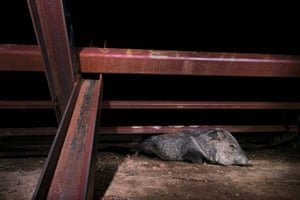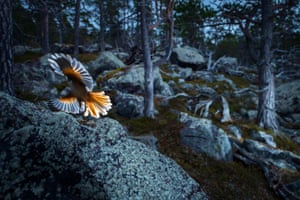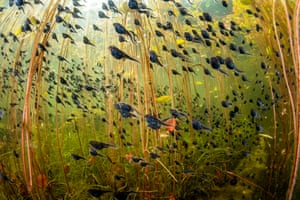
Wildlife photographer of the year 2024 winners – in pictures
The Swarm of Life by Shane Gross, who was named wildlife photographer of the year 2024. Photograph: Shane Gross/2024 Wildlife Photographer of the Year
Selected from a record-breaking 59,228 entries from 117 countries and territories, the winners of the Natural History Museum’s prestigious wildlife photographer of the year competition have been announced, with an exhibition opening on Friday 11 October. The Canadian marine conservation photojournalist Shane Gross was awarded wildlife photographer of the year 2024 for his image of tadpoles, The Swarm of Life, captured while snorkelling through lily pads in Cedar Lake on Vancouver Island, British Columbia
Free as a Bird by Alberto Román Gómez (Spain)
The winner of the 10 years and under category contrasts a delicate stonechat bird with a hefty chain. Watching from the window of his father’s car at the edge of the Sierra de Grazalema nature park, Alberto found this young bird tricky to photograph as it was quickly flying back and forth, gathering insects. To Alberto, the stonechat displayed a sense of ownership, as if it were a young guardian overseeing its territory
Photograph: Alberto Román Góme/2024 Wildlife Photographer of the Year

Life Under Dead Wood by Alexis Tinker-Tsavalas (Germany)
The winner of the 15-17 years category rolled a log over to see the fruiting bodies of slime mould and a tiny springtail. Alexis worked fast to take this photograph, as springtails can jump many times their body length in a split second. He used a technique called focus stacking, where 36 images, each with a different area in focus, are combined
Photograph: Alexis Tinker-Tsavalas/2024 Wildlife Photographer of the Year

Frontier of the Lynx by Igor Metelskiy (Russia)
The winner of the animals in their environment category shows a lynx stretching in the early evening sunshine, its body mirroring the undulating wilderness. The remote location and changing weather conditions made access to this spot – and transporting equipment there – a challenge. Metelskiy positioned his camera trap near the footprints of potential prey. It took more than six months of waiting to achieve this relaxed image of the elusive lynx
Photograph: Igor Metelskiy/2024 Wildlife Photographer of the Year

Old Man of the Glen by Fortunato Gatto (Italy)
The winner of the plants and fungi category focuses on a gnarled old birch tree adorned with pale ‘old man’s beard’ lichens. Gatto often visits the Glen Affric ancient pinewoods alone to lose himself in its intricate, chaotic, timeless beauty. The pale ‘old man’s beard’ lichens indicate that it’s an area of minimal air pollution. Analysis of pollen preserved in the layered sediments shows that the forest has stood here for at least 8,300 years
Photograph: Fortunato Gatto/2024 Wildlife Photographer of the Year

Hope for the Ninu by Jannico Kelk (Australia)
The winner of the impact award shows a ninu, with the wire grass and shrubs behind it providing a frame against the darkness. Jannico spent each morning walking the sand dunes of a conservation reserve, searching for footprints that this rabbit-sized marsupial may have left the night before. Finding tracks near a burrow, he set up his camera trap. The greater bilby has many Aboriginal names, including ninu. It was brought to near extinction through predation by introduced foxes and cats
Photograph: Jannico Kelk/2024 Wildlife Photographer of the Year

The Demolition Squad by Ingo Arndt (Germany)
This image documents the efficient dismemberment of a blue ground beetle by red wood ants. ‘Full of ant’ is how Arndt described himself after lying next to the ants’ nest for just a few minutes. Arndt watched as the red wood ants carved an already dead beetle into pieces small enough to fit through the entrance to their nest
Photograph: Ingo Arndt/2024 Wildlife Photographer of the Year

Dolphins of the Forest by Thomas Peschak (Germany/South Africa)
The winner of the photojournalist story award shows the Amazon River dolphin, one of two freshwater dolphin species living in the Amazon and Orinoco basins. Peschak documents the relationship between endangered Amazon River dolphins, also known as botos or pink river dolphins, and the people with whom they share their watery home. Traditional Amazonian beliefs hold that the dolphins can take on human form, and they are both revered and feared. Others see them as thieves who steal fish from nets and should be killed
Photograph: Thomas P Peschak/2024 Wildlife Photographer of the Year

The Serengeti of the Sea by Sage Ono (US)
The winner of the rising star portfolio award explores the abundant life around the giant kelp forests in Monterey Bay National Marine Sanctuary. Inspired by the stories told by his grandfather, a retired marine biologist, and by a photograph of a larval cusk eel, Ono acquired a compact underwater camera and decided to take up underwater photography. After university, he moved to the coast near the Monterey Bay National Marine Sanctuary in California to pursue his interest. The submerged world of the bay’s forests of giant kelp – the biggest of all seaweeds – and the diversity of life they contain have mostly captured his imagination
Photograph: Sage Ono/2024 Wildlife Photographer of the Year

On Watch by John E Marriott (Canada)
The winner of the animal portraits category frames a lynx resting, with its fully grown young sheltering from the cold wind behind it. Marriott had been tracking this family group for almost a week, wearing snowshoes and carrying light camera gear to make his way through snowy forests. When fresh tracks led him to the group, he kept his distance to make sure he didn’t disturb them. With climate change reducing snow coverage, giving other predators more opportunities to hunt hares, hare populations may decline, in turn affecting the lynx population
Photograph: John E Marriott/2024 Wildlife Photographer of the Year

Wetland Wrestle by Karine Aigner (US)
Winner of the behaviour: amphibians and reptiles category, Aigner captures a yellow anaconda as it coils itself around the snout of a yacaré caiman. The tour group Aigner was leading had stopped to photograph some marsh deer when she noticed an odd shape floating in the water. Through binoculars, Aigner quickly recognised the reptiles and watched as they struggled with each other. Caimans are generalist feeders and will eat snakes. As anacondas get larger, they will include reptiles in their diet. It’s hard to determine who is the aggressor here. On the snake’s back are two tabanids, blood-sucking horseflies that are known to target reptiles
Photograph: Karine Aigner/2024 Wildlife Photographer of the Year

The Swarm of Life by Shane Gross (Canada)
This winning image looks under the surface layer of lily pads as a mass of western toad tadpoles swim past. Western toad tadpoles swim up from the safer depths of the lake, dodging predators and trying to reach the shallows, where they can feed. The tadpoles start becoming toads between four and 12 weeks after hatching. An estimated 99% will not survive to adulthood
Photograph: Shane Gross/2024 Wildlife Photographer of the Year

Tiger in Town by Robin Darius Conz (Germany)
This image focuses on a tiger on an Indian hillside against the backdrop of a town where forests once grew. Conz was following this tiger as part of a documentary team filming the wildlife of the Western Ghats. On this day, he used a drone to watch the tiger explore its territory before it settled in this spot. The protected areas in the Western Ghats, where tigers are carefully monitored, are some of the most biodiverse landscapes in India and have a stable population of tigers
Photograph: Robin Darius Conz/2024 Wildlife Photographer of the Year

Recording by Hand by Liwia Pawłowska (Poland)
This image shows a relaxed common whitethroat gently being held by a bird ringer. Pawłowska is fascinated by bird ringing, and has been photographing ringing sessions since she was nine. She says she hopes her photograph ‘helps others to get to know this topic better’. Volunteers can assist trained staff at bird-ringing sessions, where a bird’s length, sex, condition and age are recorded. Data collected helps scientists to monitor populations and track migratory patterns, aiding conservation efforts
Photograph: Liwia Pawłowska/2024 Wildlife Photographer of the Year

Dusting for New Evidence by Britta Jaschinski (Germany/UK)
A crime scene investigator from London’s Metropolitan police dusting for prints on a confiscated tusk. Jaschinski spent time at the Border Force CITES department, where confiscated animal products are tested. Newly developed magnetic powder allows experts to obtain fingerprints from ivory up to 28 days after it was touched, increasing the chances of identifying those involved in its illegal trade
Photograph: Britta Jaschinski/2024 Wildlife Photographer of the Year

A Diet of Deadly Plastic by Justin Gilligan (Australia)
This image creates a mosaic from the 403 pieces of plastic found inside the digestive tract of a dead flesh-footed shearwater. Gilligan has been documenting Adrift Lab’s work for several years, often joining them on beach walks at dawn to collect dead chicks. The team brings together biologists from around the world to study the impact of plastic pollution on marine ecosystems. Studies found that three quarters of adult flesh-footed shearwaters breeding on Lord Howe Island – and 100% of fledglings – contained plastic.
Photograph: Justin Gilligan/2024 Wildlife Photographer of the Year

2023 
2023 wildlife photographer of the year winners – in pictures
The ancient mariner by Laurent Ballesta, France: Winner, portfolio award ‘The golden horseshoe’. A tri-spine horseshoe crab moves slowly over the mud. Location: Pangatalan Island, Palawan, the Philippines. Photograph: Laurent Ballesta/2023 Wildlife Photographer of the Year
Selected from 49,957 entries from 95 countries, the winners of the Natural History Museum’s prestigious wildlife photographer of the year competition were revealed at an awards ceremony in South Kensington on Tuesday. The flagship wildlife photographer of the year exhibition featuring the awarded images will open on Friday 13 October 2023 at the Natural History Museum in LondonHippo nursery by Mike Korostelev, Russia. Winner: underwater
Mike Korostelev reveals a hippopotamus and her two offspring resting in the shallow clear-water lake. For over two years he has been visiting the hippos in this lake and knew they were accustomed to his boat. He spent just 20 seconds under water with them – enough time to get this image from a safe distance and to avoid alarming the mother. Hippos produce one calf every two to three years. Their slow-growing population is particularly vulnerable to habitat degradation, drought, and illegal hunting for meat and ivory from their teeth. Location: Kosi Bay, iSimangaliso Wetland Park, South Africa
Photograph: Mike Korostelev/2023 Wildlife Photographer of the Year

The tadpole banquet by Juan Jesús González Ahumada, Spain. Winner, behaviour: amphibians and reptiles
Juan Jesús González Ahumada watches as toad tadpoles feast on a dead fledgling sparrow. The drama unfolded near Juan’s home when a newly fledged sparrow launched itself from a nest on his neighbour’s roof and fell into a nearby pond, where it drowned. Juan had to pick his moment to show the tadpole formation and the sparrow’s eye. Common toad tadpoles have varied diets consisting of algae, vegetation, and tiny swimming invertebrates. As they grow larger, they become more carnivorous so when a banquet like this arrives, they take full advantage. Location: Ojén, Málaga, Spain
Photograph: Juan Jesús González/2023 Wildlife Photographer of the Year

Lights fantastic by Sriram Murali, India. Winner, behaviour: invertebrates
Sriram Murali showcases a night sky and a forest illuminated with fireflies. Sriram combined 50 19-second exposures to show the firefly flashes produced over 16 minutes in the forests near his hometown. The firefly flashes start at twilight, with just a few, before the frequency increases and they pulse in unison like a wave across the forest. Fireflies, which are in fact beetles, are famous for attracting mates using bioluminescence. Darkness is a necessary ingredient in the success of this process. Light pollution affects many nocturnal creatures, but fireflies are especially susceptible. Location: Anamalai Tiger Reserve, Tamil Nadu, India
Photograph: Sriram Murali/2023 Wildlife Photographer of the Year

Whales making waves by Bertie Gregory, UK. Winner, behaviour: mammals
Bertie Gregory tracks a pod of orcas as they prepare to ‘wave wash’ a Weddell seal. Bertie took two month-long expeditions searching for orcas. ‘We spent every waking minute on the roof of the boat, scanning,’ he says. After battling high winds and freezing conditions, he captured this remarkable behaviour with his drone. These orcas belong to a group that specialises in hunting seals by charging towards the ice, creating a wave that washes the seal into the water. With rising temperatures melting ice floes, seals are spending more time on land, and the behaviour of ‘wave washing’ may disappear. Location: Antarctic Peninsula, Antarctica
Photograph: Bertie Gregory/2023 Wildlife Photographer of the Year

Face of the forest by Vishnu Gopal, India. Winner, animal portraits
Vishnu Gopal records the moment a lowland tapir steps cautiously out of the swampy Brazilian rainforest. Finding hoofprints on a forest track near his campsite, Vishnu waited nearby. An hour later, the tapir appeared. Using a long exposure and torchlight to capture texture and movement, Vishnu framed the tapir’s side-turned head as it emerged from the forest. Lowland tapirs rely on the forest for their diet of fruit and other vegetation and in turn the tapirs act as seed dispersers. This important relationship is threatened by habitat loss, illegal hunting and traffic collisions. Location: Tapiraí, São Paulo, Brazil
Photograph: Vishnu Gopal/2023 Wildlife Photographer of the Year

Life on the edge by Amit Eshel, Israel. Winner, animals in their environment
Amit Eshel witnesses a dramatic cliffside clash between two Nubian ibex. After hiking to a vantage point on the clifftop, Amit crept closer, using a wide-angle lens to set the two clashing Nubian ibex against the dramatic backdrop. The battle lasted for about 15 minutes before one male surrendered, and the pair parted without serious injury. In the run-up to the mating season, part of the males’ coat darkens, and their neck muscles thicken. Rivals will raise up on their hind legs and ram their heads together. Their horns sometimes break as they collide. Location: Zin Desert, Israel
Photograph: Amit Eshel/2023 Wildlife Photographer of the Year

The ancient mariner by Laurent Ballesta, France. Winner, portfolio award ‘The golden horseshoe’
A tri-spine horseshoe crab moves slowly over the mud. Its golden protective carapace hides 12 appendages. Above the horseshoe crab, a trio of juvenile golden trevallies are poised to dart down for edible morsels ploughed up by its passage.Portfolio Story: Laurent Ballesta went looking for the crabs in the protected waters of Pangatalan Island in the Philippines. Marine biologist and photographer Laurent Ballesta has dedicated his life to exploring the oceans and revealing their wonder through art. He has led a series of expeditions, all involving scientific mysteries and diving challenges, resulting in unprecedented images. The tri-spine horseshoe crab has survived for more than 100m years but faces habitat destruction and overfishing for food and for its blood, used in the development of vaccines. But, in the protected waters off Pangatalan Island, there is hope for its survival. Location: Pangatalan Island, Palawan, the Philippines
Photograph: Laurent Ballesta/2023 Wildlife Photographer of the Year

Last breath of autumn by Agorastos Papatsanis, Greece. Winner, plants and fungi
Agorastos Papatsanis reveals the magic of a fungus releasing its spores in the forest. Long-fascinated by fungi, Agorastos used his silver photographic umbrella to stop his camera getting wet, and covered his flash with a plastic bag. The colourful touches come from refraction of the light passing through the spore-laden air currents and rain. Parasol mushrooms release spores from the gills under their cap. Billions of tiny spores travel – usually unseen – in the air currents. Some will land where there is moisture and food, enabling them to grow networks under the forest floor. Location: Mount Olympus, Pieria, Greece
Photograph: Agorastos Papatsanis/2023 Wildlife Photographer of the Year

Alpine exposure by Luca Melcarne, France. Winner, rising star portfolio award
‘The ice ibex’ To enable an early ascent into ibex territory, Luca had spent a bitterly cold night in a temporary shelter in the French Alps, having skied for six hours across the natural park. Luca thawed his camera with his breath and took the ibex’s portrait. Story: Luca Melcarne makes the most of his mountain-guide skills to reveal the fascinating lives of Alpine animals. Born at the foot of the Vercors mountains in France, Luca is a professional mountain guide and nature photographer. He is addicted to the cold, constantly watching the weather to make his plans. This portfolio highlights the animals that live in the Vercors. His remarkable images demonstrate how patience, perseverance and passion are essential ingredients for dramatic wildlife photography. Location: Vercors regional natural park, Rhône-Alpes, France
Photograph: Luca Melcarne/2023 Wildlife Photographer of the Year

Last gasp by Lennart Verheuvel, the Netherlands. Winner, oceans: the bigger picture
Lennart Verheuvel shows the final moments of a beached orca. Lying on its side in the surf, this orca had only a short time left to live. Initially rescued, it was soon stranded again on the beach and died. A study later revealed that not only was it severely malnourished, it was also extremely sick. Research shows that orcas in European waters have the world’s highest concentrations of polychlorinated biphenyls. These banned chemicals can persist for many years in marine food webs, weakening immune systems and reducing breeding success in whales, porpoises and dolphins. Location: Cadzand-Bad, Zeeland, the Netherlands
Photograph: Lennart Verheuvel/2023 Wildlife Photographer of the Year

Birds of the midnight sun by Knut-Sverre Horn, Norway. Winner, Urban Wildlife
Knut-Sverre Horn offers a glimpse of kittiwake chicks illuminated in an abandoned factory. From his vantage point inside an abandoned fish-processing factory, Knut-Sverre kept watch on the black-legged kittiwakes tending to their chicks on the windowsill. As midnight approached, the low summer sun struck the north-facing window, sharpening the birds’ silhouettes and giving him the image that he wanted. Kittiwakes naturally nest on the narrow ledges of high, steep coastal cliffs. Recently numbers have plummeted, and some have headed for urban areas due to shortages of food caused by warming oceans and pollution. Location: Vardø, Troms og Finnmark, Norway
Photograph: Knut Sverre Horn/2023 Wildlife Photographer of the Year

The unprotected by Karine Aigner, US. Winner, photojournalist story award
‘Big business’ contestants line up to have their bobcats weighed in the March 2022 West Texas Big Bobcat Contest, the highest-paying predator-hunting contest in the US. There are a number of prizes, one of which is for the heaviest bobcat. In 2022 the winner of that category took home US$35,530 (around £28,000). Portfolio Story: Karine Aigner documents the annual hunting competitions in Texas, US. For some people in the US, hunting wildlife is a pastime. In Texas, while there are strict regulations covering ‘game’ species, certain predators such as bobcats, mountain lions and coyotes have no protection and can be killed at any time. In this portfolio, Karine delves deep into the contests and festivals that celebrate the killing of these unprotected and maligned species, exploring their relationship with humans.
Photograph: Karine Aigner/2023 Wildlife Photographer of the Year

The dead river by Joan de la Malla, Spain. Winner, wetlands – the bigger picture
Joan de la Malla provides a bird’s-eye view of the polluted Ciliwung River winding through Indonesia’s capital, Jakarta. To find a time when lower air pollution allowed a clear view, Joan returned to the scene over several days. His image documents one of the most polluted rivers in the world and illustrates the growing global issue of river pollution. Plastic rubbish, human waste, agricultural fertilisers and factory waste are suffocating the river. As a result, Jakarta’s residents are having to use groundwater for drinking water. This has resulted in widespread subsidence and the city is now sinking. Location: Ciliwung River, Jakarta, Indonesia
Photograph: Joan de la Malla/2023 Wildlife Photographer of the Year

Silence for the snake show by Hadrien Lalagüe, France. Winner, behaviour: birds
Hadrien Lalagüe is rewarded for his patience with a perfect alignment of grey-winged trumpeters watching a boa slither past. Hadrien set up his camera trap by a track in the rainforest surrounding Guiana Space Center. He spent the next six months maintaining the camera kit against high humidity, plastic-munching ants and damage by poachers. This image was his reward. Trumpeters – named for their loud calls – spend most of their time foraging on the forest floor, eating ripe fruits, insects and the occasional small snake. The boa constrictor, more than 3 metres (9.8ft) long, could have made a meal of them. Location: Guiana Space Center, between Kourou and Sinnamary, French Guiana
Photograph: Hadrien Lalagüe/2023 Wildlife Photographer of the Year

The tourism bulldozer by Fernando Constantino Martínez Belmar, Mexico. Winner, photojournalism
Fernando Constantino Martínez Belmar (Mexico) shows the devastating path of a new cross-country tourist railway line. To reach a point from where he could launch his drone, Fernando was guided through 4km (2.5 miles) of an underground cave system. The result of his challenging trek was this image. The government-funded railway line connecting tourist destinations brings economic benefits to Mexico’s south-east, but it also fragments ecosystems, threatens protected reserves and archaeological sites, and impacts Indigenous peoples. While trains are a more environmentally friendly form of transport, conservationists warn of devastating consequences. Location: Paamul, Quintana Roo, Mexico
Photograph: Fernando Constantino Martínez Belmar/2023 Wildlife Photographer of the Year

Owls’ road house by Carmel Bechler, Israel. Winner, 15-17 years
Carmel Bechler discovered several barn owls in an abandoned concrete building near a busy road. Returning to where he had spotted a barn owl the previous year, Carmel and his father used the family car as a hide. He made the most of the natural light and used long exposure times to capture the light trails of passing traffic. Israel has the densest barn-owl population in the world. A national project has provided nesting boxes near agricultural fields, encouraging owls to nest near farmland. Because the owls hunt rodents that eat seeds and crops, this arrangement has reduced the use of pesticides on farms.
Photograph: 2023 Wildlife Photographer of the Year

Wildlife photographer of the year. Out of the blue by Ekaterina Bee, Italy. Winner, 11-14 years
Ekaterina Bee shares her intimate encounter with some common bottlenose dolphins. Ekaterina’s trip to the west coast of Scotland was filled with wildlife encounters, but bottlenose dolphins were an unexpected surprise. From the boat she composed this image, which highlights the surface patterns on the water created by the dolphins’ movements. Common bottlenose dolphins can be found throughout the world’s oceans except in polar regions. Living in small groups, they are highly social animals, and are one of the top marine predators living in Scottish waters. Location: Portree, Isle of Skye, Scotland, UK
Photograph: Ekaterina Bee/2023 Wildlife Photographer of the Year

The wall of wonder by Vihaan Talya Vikas, India. Winner, 10 years and under
Vihaan Talya Vikas watches as an ornamental tree trunk spider prevents its prey from escaping. This was Vihaan’s first visit to the tamarind grove. Fascinated by stories of the Hindu god Krishna, it seemed to Vihaan as if the spider had positioned its web after being entranced by the sound of Krishna’s flute. This spider is an orb weaver, which creates a wheel-shaped web of sticky threads to catch flying insects. As the spider grows, it elongates its web, which entangles anything that lands on it. Location: Nallur Heritage Tamarind Grove, Karnataka, India
Photograph: Vihaan Talya Vikas/2023 Wildlife Photographer of the Year

2020

2020 GDT European wildlife photographer of the year – winners
A Monkey’s Mask.
The winners of the European wildlife photographer of the year have been chosen in the competition’s first virtual award ceremony. Jasper Doest’s striking shot, A Monkey’s Mask, was declared overall winner
Birds category winner: Penguin Defence
A column of king penguins in St Andrews Bay
Photograph: Ben Cranke/2020 GDT European wildlife photographer of the year

Bird category runner-up: Bride and Groom
Photograph: Bernt Østhus/2020 GDT European wildlife photographer of the year

Mammals category winner: So Big and Yet so Small
An elephant on the shore of Kariba reservoir
Photograph: Christoph Kaula/2020 GDT European wildlife photographer of the year

Mammals category runner-up: Scratching
Photograph: Wolfgang Veeser/2020 GDT European wildlife photographer of the year

Other animals category winner: A Father and his Offspring
A frog endemic to Sierra Nevada de Santa Marta National Park, Colombia
Photograph: Jaime Culebras/2020 GDT European wildlife photographer of the year

Other animals category runner-up: Curious Glances
Photograph: Manuel Plaickner/2020 GDT European wildlife photographer of the year

Plants and fungi category winner: Blooming Desert
A desert rose shedding its foliage during the dry season and producing flowers instead
Photograph: Marcus Gaiotti/2020 GDT European wildlife photographer of the year

Plants and fungi category runner-up: Frosty Aura
Photograph: Hannu Ahonen/2020 GDT European wildlife photographer of the year

Landscapes category winner: Mammatus Clouds Over the Dolomites
Photograph: Georg Kantioler/2020 GDT European wildlife photographer of the year

Landscapes category runner-up: Yin and Yang
Photograph: Theo Bosboom/2020 GDT European wildlife photographer of the year

Underwater world category winner: Whale Milk
A sperm whale feeding her calf
Photograph: Mike Korostelev/2020 GDT European wildlife photographer of the year

Underwater world category runner-up: Hitchhiking Octopus
Photograph: Magnus Lundgren/2020 GDT European wildlife photographer of the year

Man and nature category winner: Empathy
An orphaned gorilla at a health examination
Photograph: Marcus Westberg/2020 GDT European wildlife photographer of the year

Man and nature category runner-up: Fighting No Matter What
Photograph: Alvaro Herrero/2020 GDT European wildlife photographer of the year

Nature’s studio category winner: Galaxy
The reflection of a barn swallow in flight
Photograph: Thomas Hempelmann/2020 GDT European wildlife photographer of the year

Overall winner: A Monkey’s Mask
The photo originates from a traditional Japanese sake house north of Tokyo. After dinner, the tavern’s guests can watch Japanese macaques performing tricks with various props on a makeshift stage. In the old days, the Japanese macaque, or snow monkey, was a sacred religious symbol, known to mediate between gods and humans. Today, the animal has been reduced to a secular scapegoat, a defaced outcast and target of mockery.
Photograph: Jasper Doest/2020 GDT European wildlife photographer of the year

Nature’s studio category runner-up: Blue River
Photograph: Gheorghe Popa/2020 GDT European wildlife photographer of the year

Young photographers (up to 14 years of age) winner: Backlight
An Iberian lynx at sunset in southern Spain
Photograph: Andres Dominguez Blanco/2020 GDT European wildlife photographer of the year

Young photographers (15-17) winner: Tiny Details
A lesser horseshoe bat
Photograph: Lili Sztrehárszki/2020 GDT European wildlife photographer of the year

Fritz Pölking prize : Welcome to Mexico
A project about the ecosystem along the US – Mexico border
Photograph: Alejandro Prieto/2020 GDT European wildlife photographer of the year

Fritz Pölking junior prize: Blaze of Colours
A portfolio about the Siberian jay in the deepest forests of Lapland
Photograph: Florian Smit/2020 GDT European wildlife photographer of the year

